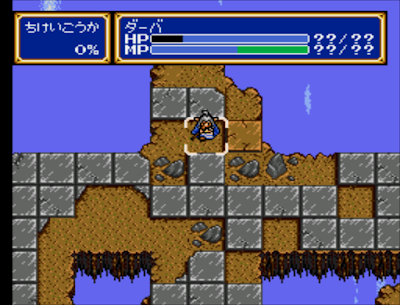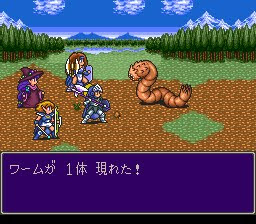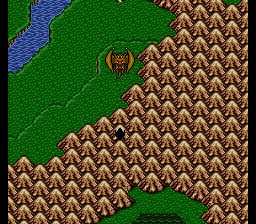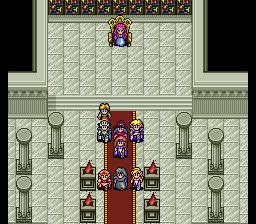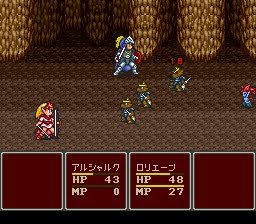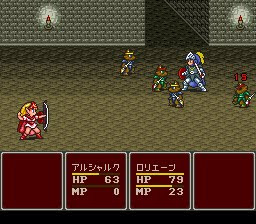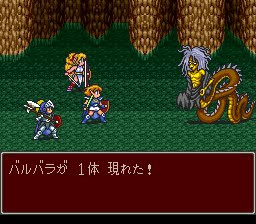As with the previous Super Robot Taisen games, this is a collection of message board posts from over 10 years ago when I played this game. They are somewhat sparse because I found it hard to say much about this game — the story is virtually nonexistent and until you get to Shu’s route (the third one) the game is brain-dead easy. Apparently this was an intentional choice by the designers to get kids interested who didn’t remember the old 70s anime series that the previous games were largely based on.
—
Eight months after SRW 3, the next game, called SRW EX, came out. EX is an oddball in the franchise — although the focus is on the original characters and the whole thing takes place in La Gias, there are licensed characters in the game as well. It’s the first time the idea of the original main character appeared (even though the main characters had all been in SRW 3).
This is somewhat speculative, but from what I’ve seen on Japanese sites, it looks like the early SRW games did not sell particularly well. Apparently the games were seen as being mostly for adults that remembered the Super Robot anime from the 70’s — this also explains the major focus on Gundam that is seen in the early games. Supposedly SRW EX was an attempt to reach out to younger players who were not familiar with the old robot anime.
All the series from 3 return, minus Daitarn 3, Combattler V, and Raideen. New series appearing are Goshogun and Aura Battler Dunbine.
The system is based on SRW 3 but takes more steps towards the modern SRW engine. The changes I know of are:
– Once you see the hit percentages, you can now hit B to take the attack back.
– You can now upgrade weapons.
– The numbers have been scaled up a lot (i.e. Cosmo Nova was 2000 in SRW 3, and 6800 in EX).
– If a robot has multiple pilots, they can now all use seishin rather than just the main pilot.
– In SRW 3, all range 1 (and only range 1) weapons were post-move; EX adds the “P” designation that later SRWs have to show that a weapon is post range (and it’s not just all range 1s).
– The animations in EX are a little more dynamic — weapons now appear on the sprites, and the sprites can move in all directions (not just left and right).
– You still can’t decide on the fly whether to dodge, block, or counter. But now you can decide between “always dodge/block”, “always counter”, etc. on a per-unit basis rather than having to just select one option for your whole team.
– MAP attacks now have animations
There are three different routes in the game; I will be starting with Masaki’s.
Stage M1 – Disturbance in Langran
Compare this stage to the first stage of SRW 3, and you can see that they were going for an easier fight. 1 vs. 5 here, and SRW 3’s first fight is 9 vs. 18 (including the reinforcements). You can win this fight in one turn with Cyflash.
Kuro and Shiro, Masaki’s familiars, make their first appearance here. They have never been mentioned before (unless they were in Hero Senki?) [2019 Kurisu: They are not in Hero Senki]
Surprisingly, they did not reuse the SRW 3 sprites:
[2019 Kurisu: Sorry for the photobucket watermarks; it would take too long to get the original images and fix that]

Stage M2 – The Summoning
In SRW 3, this stage would have been hard. You fight Jerid, Kakricon, the three Black Stars, and some grunts, and your only decent units are Goshogun and Cybuster. But here it’s pretty easy. Even the named units go down easily.
Goshogun makes its debut here, although from what I understand, the robot never actually joins you properly during EX.
There is a lot more dialogue in this game than there was in SRW 3.
Stage M3 – Attack at Imortal
Mio appears in the Diablo here.

Kouji and Sayaka also show up here. Here’s the Mazinger comparison so far:

But this is kind of interesting; jumping the gun a little bit but look at the SRW 4 Mazinger:

It looks like they went back to the SRW 3 sprites after EX.
Stage M4 – Aura Battlers
Aura Battler Dunbine enters SRW with Shou in the Bilvine and Marvel Frozen in the Dunbine:

This stage is the first one to represent a very slight challenge; the floating fortress has a lot of HP and can do some decent damage. But really just smack him around with Mazinger and you’ll be fine. Unfortunately you still can’t see how much damage you’re doing if the guy has over 10,000 HP. I hope they fix this by 4.
Stage M5 – Holy Girl
Stage M6 – Solatis Temple
Stage M7 – Demon Hack
These stages are pretty repetitive; just fighting one type of enemy (mostly demon golems) on each one. Stage 5 actually presents the first real challenge of the game; you have Ruozor who gets double move, but you can’t kill him. So you just have to hope he doesn’t kill anybody before you get the demon golems.
Stage M8 – Coral Canyon
Stage M9 – Coral Canyon again
Stage 8 is just a story sequence; basically the idea of these two stages is that Leena was kidnapped so you fight ZZ and F91 for a few turns until she gets saved. Tytti also appears (her name is often spelled Tootie or Tutie but Tytti is a real scandinavian name).
Now a little digression on why this game is boring. It’s very similar to SRW 3 in that the story is pretty thin — it’s basically just “Now we’re going to place X, uh-oh, more enemies.” The Shutedonias Army is basically the Divine Crusaders with a couple of new mechs. The main difference is that the named characters lack the background that the source anime give them. Jog and the woman from this stage are completely unmemorable because they have no backgrounds and no personalities.
M10-M16
I really don’t have much to say about these stages because they are almost the same. The maps are so easy that there’s no individuality to the boards (you just use MAP attacks and everything dies, including the bosses). The story is still lacking but Shuu has come in so I guess it might get a bit more interesting. I’m looking forward to 4, though.
Ryuune 1-3
Ryuune’s route so far is similar to Masaki’s, but with fewer MAP attacks. The enemy groups are the same, though. For this route I get Getter G, Zeta, and Nu Gundam, all welcome sights.
Stage 4-7 (Ryuune)
This route takes place at the same time as Masaki’s, but shows another side of the story (with Kirkus’ armies). Kind of an interesting idea, but the plot is just too thin for it to be interesting. So far Ryuune’s route is a little harder than Masaki’s, but not a whole lot. There’s a lot of good terrain to sit on with EN regeneration.
(Sorry these updates are short; EX is pretty boring so I’m not that motivated to make longer updates or post screenshots.)
—
Still snoring along, up to Ryuune 12 now. Hathaway Noah is a character in this game; he’s a rare character in SRW. Other than that, Ryuune’s route is pretty much the same as Masaki’s route so I don’t have much more comment.
Stage R13 – Protect Zeb Temple
This stage was actually fairly hard. You have to kill all the enemies in 9 turns. I was able to make almost 200,000 from Luck plus the good enemies, but I finished the stage with almost the last attack on stage 9.
Ryuune agrees to a date with Zash (Kirkus’ son); I guess Masaki has a rival now. Maybe this will be continued in MK part 2.
I finished Ryuune’s route; the final stage is semi-hard, against 2 Valsion Kais and the Eurid. It wasn’t too bad, though. The key to the game, like most of the early SRWs, is to update all your most powerful non-beam attacks. You can kill a Valsion Kai each round until they’re dead, then go after Eurid. Put your battleship out in front because the enemies like to attack it; 5 or 6 guys should have Love seishin, which is enough to keep your HP up.
Here are pictures of the two bosses so far (the Draxil and the Eurid):

[2019: This is in a response to the usefulness of the Dunbine units in the SNES version compared to the Playstation remake] Raising them to 130 morale in the original version is too hard, because they have no defensive seishin, and there just aren’t enough enemies. You would basically have to kill one enemy, end turn, kill a second enemy, end turn, etc. until you kill 5 or 6. You can’t really use counterattacks, since you can’t pick counter or dodge on a per-attack basis (also you can’t upgrade mobility and there’s no items, so the famed 0% of AB units is not in this game). In Masaki’s route it’s much faster just to use Breast Fire and Thunder Break to kill the Vorkruss parts. I agree with mediocrity that they are almost certainly better in the CB version.
I played through Shu 7. His route is kind of fun, because Shu is neat, but the gameplay is still mostly the same maps as before. This was a LOL:

Safine: Watch very carefully, so that Monica doesn’t get her hands on Shu!
Chika: You don’t have to worry about that, Safine. My master has so little interest in women that I sometimes wonder if he’s gay.
(Maybe that’s only funny because they made Shu’s voice actor Koyasu Takehito.)
Shu’s route is the hardest in the original game. In Stage 9 you can get the Sazabi and a Doven Wolf but you have to beat all the enemies in 6 turns, without Granzon. It’s tough, but you can do it if you have Safine focus on the Quin Mantha, and take out the Dai with a hot blood MAP attack from Quattro.
Beat the game. Shu’s route is definitely better than the other two, although it is harder. What you want to do is get all the optional units and characters. Fully upgrade Granzon’s Black Hole Cluster, Solgadi’s most powerful attack, Terius’ mech’s most powerful attack, and Sazabi’s fin funnels. For the final stage vs. True Vorkruss you can set up all your guys outside of his attack range (one person has to be in his range, though, or he’ll move) and kill him in 2 or 3 turns:

Safine will be an enemy in the last stage if her level is 30 or lower. After the battle, Monica says this:

Monica: Safine…she was vulgar, domineering, sadistic, masochistic, a nymphomaniac, a bad person, and there was nothing you could do about it…even so…
This is her quote in the character database of Alpha Gaiden; I always wondered what the context was. (It always sounded to me like she was saying this to Safine, and I wondered what came after the “so…”, which turns out to be “she didn’t deserve to die like that”) However, I think having Safine die is not canon because she’s in 4.
Finally I’m done with EX. As I said in earlier posts, this is not a very good game. It’s definitely the worst SRW I have played so far. Shu’s route was kind of fun, but that’s about it.
































